Uncategorized
How Donald Trump and JD Vance Should Respond to Rising Antisemitism

U.S. President Donald Trump delivers an address to the nation accompanied by U.S. Vice President JD Vance, U.S. Secretary of State Marco Rubio and U.S. Defense Secretary Pete Hegseth, at the White House in Washington, D.C., U.S. June 21, 2025. Photo: Carlos Barria via Reuters Connect.
An irony of the Trump administration is that it has done more than any predecessor in recent memory to push back against antisemitism on the left, only to watch it rise on the political right.
The far-left in America views the Jews as among the “white” ruling class and seeks liberation from supposed Jewish oppressors. Meanwhile, the far-right questions the loyalty of American Jews, whom they view as powerful manipulators of the US government and inimical to “white America.”
Whereas pro-Jewish Christians take God’s Biblical injunction to Abraham — “I will bless those that bless thee and curse those that curse thee” — literally, a growing number of young Christians now subscribe to “replacement theology.” This antisemitic belief holds that Christians have replaced Jews as God’s “chosen people” and therefore bear no commitment to their well-being.
The rise of “replacement theology” within the American right has coincided with a resurgence of “replacement theory,” which argues that Jews and other minorities are systematically replacing White Christians in the US. These two canards – one theological, the other racial – have gained new purchase as the right’s traditional guardrails against antisemitism have eroded.
This antisemitism is not just creeping into the mainstream — it is rushing into it.
And the spread of antisemitism is aided by those who either refuse to address it, or even explicitly tolerate it, putting political expediency ahead of principles. This has been the case mostly on the left in recent years, as witnessed by the rise of Zohran Mamdani and his endorsement by prominent Democrats.
But the growing popularity of Tucker Carlson, who platforms antisemites like Nick Fuentes and recently declared that the people he hates most are Christian Zionists, is equally concerning.
That Kevin Roberts, who heads the conservative Heritage Foundation, said that Carlson will “always” be a friend casts a dark shadow over an institution long known for its prudent, sensible conservatism. Roberts is no William Buckley, the intellectual godfather of the modern American right, who distanced himself from the extremist John Birch society and made clear that antisemitism has no place in American conservatism.
There is nothing more dangerous to America than the growing normalization of antisemitism on both sides of the political divide. America’s embrace of the Jews — unlike the old world that expelled, ghettoized, marginalized, and murdered them — has been a pillar of American principles. And Jews, in turn, have embraced and loved America like no other nation that came before it, referring to it as the “golden state” and seeing in its liberal values their salvation from millennia of persecution.
Our greatest statesmen have all known that America is healthy when it gives full rights and respect to Jewish Americans.
“May the Children of the Stock of Abraham, who dwell in this land, continue to merit and enjoy the good will of the other Inhabitants,” George Washington wished the Hebrew Congregation of Newport, Rhode Island in 1790. America, he added, “gives to bigotry no sanction, to persecution no assistance.”
Almost two centuries later, Ronald Reagan recalled that America’s divine providence is grounded in its shared Judeo-Christian heritage, observing that “Americans… are not Jews or Christians …. They are Americans awed by what has gone before, proud of what for them is still … a shining city on a hill.”
Conversely, an America in which there is no place for Jews, in which Jews are not seen as Americans or afforded the right to live freely as Jews, will be cast down from that hill.
If allowed to spread from the extremities into the bloodstream of American political discourse, antisemitism will surely devour and destroy the soul of our great nation, just as it has that of all those societies whom it has infected in the last century: Venezuela, Iran, the Soviet Union, Germany. These acts usually reflect, or are harbingers of, larger destructive forces.
Winston Churchill, perhaps the greatest Western statesman of the 20th century (and, unsurprisingly, an object of derision by Carlson), understood this well when he decried anti-Jewish pogroms in Czarist Russia.
As JINSA President & CEO Michael Makovsky writes in Churchill’s Promised Land, Churchill employed an adage attributed to Benjamin Disraeli: “The Lord deals with the nations as the nations dealt with the Jews.”
President Trump and Vice President Vance should follow in the footsteps of Washington and Reagan, ostracize this antisemitism, and restore America to its rightful place on the hill.
Jared Stone is Research Associate for the President & CEO of the Jewish Institute for National Security of America (JINSA). He is the author of the newly released book, A Brief History of Israel and the Jewish People.
Uncategorized
How hundreds of forgotten klezmer tunes have been rescued from oblivion
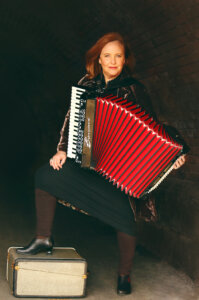
More than one thousand klezmer tunes, some dating back to the late 19th Century, are being performed and recorded after sitting in a library in Kiev for years, thanks to the nonprofit Klezmer Institute.
“This increases European klezmer music by fourfold over what was accessible before,” Christina Crowder, the New Haven-based accordion player who heads the institute, told me, adding that the collection ranges from virtuosic solo pieces to “workaday, regular old tunes.”
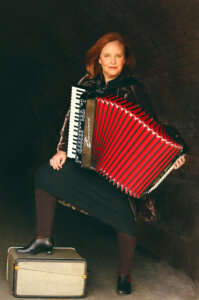
Digital photos of hundreds of pages of sheet music arrived on a memory stick at the Yiddish New York gathering in 2017, but the crowd-sourced effort to turn them into PDF files and share them on the web didn’t get going in earnest until late 2020. In the last couple of years, several albums featuring the resurrected klezmer tunes have been recorded. Crowder estimates that at least 72 musicians have digitized at least one tune for what has been dubbed the Kiselgof-Makonovetsky Digital Manuscript Project (KMDMP).
The project is working with a total of close to 1,400 tunes from two different sources: 26 notebooks of melodies collected by Zusman Kiselgof, a Russian folklorist who participated in the seminal An-ski ethnographic expeditions, and a 236-page manuscript by Avraham Yehoshua Makonovetsky, a Russian klezmer violinist who played at Jewish weddings. Both Kiselgof and Makonovetsky were Jews. The notebooks and the manuscript had been sitting in the Vernadsky National Library of Ukraine.
“This is of incredible value,” Lyudmila Sholokhova, curator of the Dorot Jewish Collection at the New York Public Library, told me. She inventoried the Edison wax cylinder recordings of the Kiselgof collection when she worked at the Vernadsky and wrote her doctoral dissertation on early efforts to collect Jewish music in the Russian Pale of Settlement.
“This is a lot of unknown music and it also gives you a good idea how this music was actually played,” she said of the Kiselgof-Makonovetsky collection. A small number of the tunes has been circulating in recent years before the KMDMP began.
The mixed blessing of COVID
The COVID lockdown turned out to be a blessing for the KMDMP because klezmer musicians were unable to play gigs or rehearse with their bandmates. So, they went to work digitizing the klezmer treasure trove.
“In the beginning during lockdown, you couldn’t go out to a gym, you couldn’t go play music with people. In the evening you can’t practice at home because there are neighbors. So, you digitize tunes,” Hannah Ochner told me.
The German klezmer clarinetist now lives in England and fronts a klezmer ensemble called Hop Skotshne. Ochner, 33, has a PhD. in physics and her main gig is researching electron microscopy in Cambridge. But she still found time to digitize an estimated 600 tunes over the course of a year and a half.
“It became addictive,” she said.
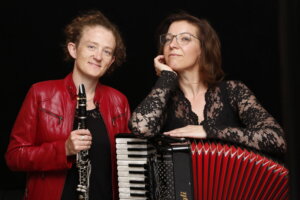
One of the untitled tunes Ochner worked on was a skotshne, a lively klezmer dance melody. The digital photo she worked from depicted a crumpled page, necessitating quite a bit of reconstruction.
“The length of the notes I left was longer than the music score,” she said.
The tune, Hannah’s Skotshne, was named in her honor.
Crowder said some of the hand-written scores were “a real mess.”
“You have to be a special kind of nerd to want to dive into this stuff,” she told me. “You’ve got four tunes crammed on the page and there’s mistakes and there’s all kinds of random old school notation.”
Crowder estimates that in addition to klezmer nerds like Ochner, a pool of more than 200 volunteers has helped by translating Russian or Yiddish text on sheet music or joined bi-weekly Zoom sessions where musicians play along with Crowder as she goes through tunes on her accordion.
The KMDMP now has at least a thousand klezmer melodies available for download as PDF’s, and Crowder said there are plans to publish a scholarly edition of some Kiselgof-Makonovetsky tunes as bound volumes. The Klezmer Institute is also planning to commission piano accompaniments for the many virtuosic solo violin pieces in the collection.
“They would be a lot of fun for a classically trained violinist to approach and to put into their own repertoire,” said Crowder. “Violin players don’t want to play clarinet pieces because they’re clarinet pieces.”
Music with global appeal
The KMDMP repertoire has been spreading at klezmer festivals in Europe and North America. The New York-based trumpeter Jordan Hirsch has passed them on to students at KlezKanada and Yiddish New York. Susi Evans and Szilvia Csaranko, a klezmer duo based in the UK and Germany, have taught the tunes at Shtetl Berlin jam sessions and Yiddish Summer Weimar, Europe’s major klezmer and Yiddish culture gathering.
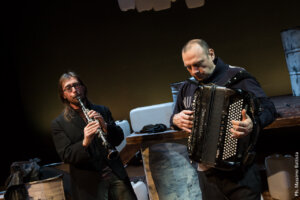
Csaranko, an accordion player, is the musical director of Klezmerorchester Erfurt, an 80-piece amateur ensemble in Germany that performed a concert of the Kiselgof-Makonovetsky repertoire in 2022 before an outdoor audience of 3,000.
Evans, a clarinetist who has performed as a soloist with the BBC Scottish Symphony Orchestra, told me: “If you’re teaching klezmer music regularly, you’re always looking for tunes that someone who’s come into the workshop and knows a lot of tunes, won’t know.”
Their double CD, Fun an Altn Klezmer Heft, features 44 Kiselgof-Makonovetsky tunes, including “Hannah’s Skotshne.”
“Wherever we go, we like to spread these melodies,” Csaranko told me. “People do play these melodies they heard from us in jam sessions, in different countries. People in Australia are playing them now because they were in our workshop.”
The classically-trained clarinetist Angelo Baselli in Bologna, Italy teamed up with the accordionist Gianluca Casadei to record Fun a Velt Vos iz Nishto Mer, Of a World That Is No More. The album features Kiselgof-Makonovetsky tunes.
In a telephone interview Baselli, 47, said he caught the klezmer bug nearly 30 years ago after listening to Don Byron Plays the Music of Mickey Katz.
“I don’t have a Jewish family but instantly I fall in love with that music,” Baselli told me. “I started to search for recordings but at that time it was a little bit hard because there wasn’t a klezmer movement in Italy.”
A musical heirloom
Two klezmer trios in the Bay Area of Northern California have Kiselgof-Makonovetsky tracks on their most recent albums, both on the Borscht Beat label. Baymele’s album is Sapling. The new Veretski Pass album, The Peacock and the Sunflower, has eight Kiselgof-Makonovetsky numbers.
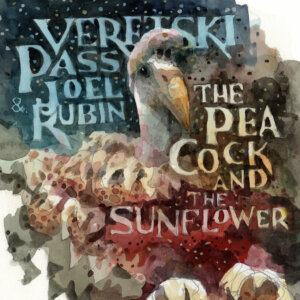
The Veretski Pass accordion player, Josh Horowitz, actually went to Ukraine before the KMDMP began and brought back some of the klezmer tunes from the collection.
“They were passed around like contraband at festivals,” the band’s violinist, Cookie Segelstein, said.
Their trio is named for a mountain pass in Ukraine where Segelstein’s father was born. Her mother grew up 45 miles away in the town Munkacs, where the Munkacher Hasidic sect began. So, for Segelstein, the archive of Kiselgof-Makonovetsky tunes is like a family heirloom.
“I have no way of going back to Veretski or where my mom is from and seeing her home because it was either destroyed or other people lived there,” she told me.
Describing the process of going through the unearthed klezmer tunes, Segelstein said: “We were digging through ashes. We would never have had this kind of access to this many historical tunes. To have this trove in one place has been like winning the lottery.”
The post How hundreds of forgotten klezmer tunes have been rescued from oblivion appeared first on The Forward.
Uncategorized
An activist Jewish artist who used his work to fight fascism
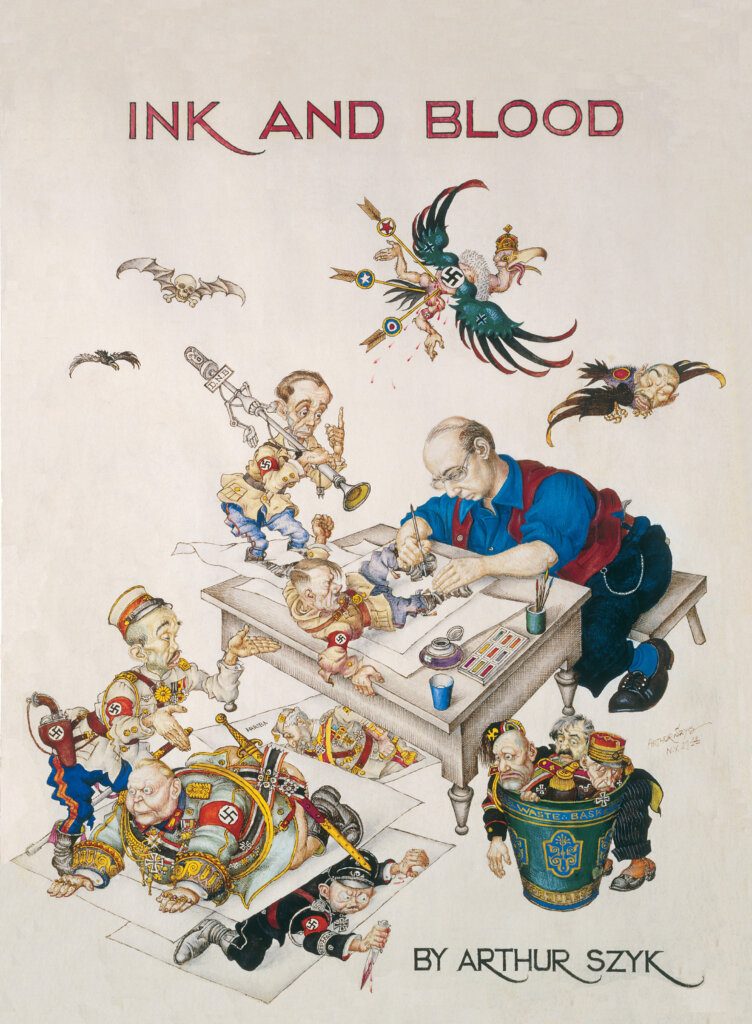
The heroic image of George Washington standing in a boat as it cuts through the icy Delaware River on Christmas Eve in 1776 is etched into the collective American consciousness. But when Polish-born political artist Arthur Szyk painted the scene in 1942, he recast it for a nation at war.
In his Washington Crossing the Delaware, the soldiers are not uniform. Instead, they reflect a diverse America, where freedom and protection belong to everyone. Intricately detailed, the richly pigmented painting is one of more than 100 works by Szyk on view in Art of Freedom: The Life and Work of Arthur Szyk at New York City’s Museum of Jewish Heritage. The exhibition pulls together rarely seen material into public view as the United States approaches the 250th anniversary of its founding.

“What makes this exhibition and celebration of Arthur Szyk important for 2026 — 250 years on from the American Revolution and subsequent Declaration of Independence — is how he framed freedom as something to fight for. He loved America and was granted citizenship in 1948,” said Sara Softness, the museum’s director of curatorial affairs. “The title ‘Art of Freedom’ has a double meaning: not only that the artist made pictures about or featuring themes of democratic ideals, anti-Fascism, and pro-pluralism, but that freedom itself is a practice, a metier, a life’s work.”
Born in Łódź, Poland in 1894, Szyk experienced major upheavals of the 20th century: two world wars, the rise of totalitarianism, and Nazism, the founding of the State of Israel, McCarthyism, as well as deeply entrenched American racism and antisemitism.
After Germany invaded Poland in 1939, he, his wife and two children fled to London, ultimately immigrating to the United States in 1940.
While Szyk was an established artist when he arrived in the U.S., most Americans first encountered him through the lavishly illuminated Szyk Haggadah. Completed in Poland in the 1930s and published in London in 1940, The Times of London praised the work as “worthy to be placed among the most beautiful of books that the hand of man has ever produced.”
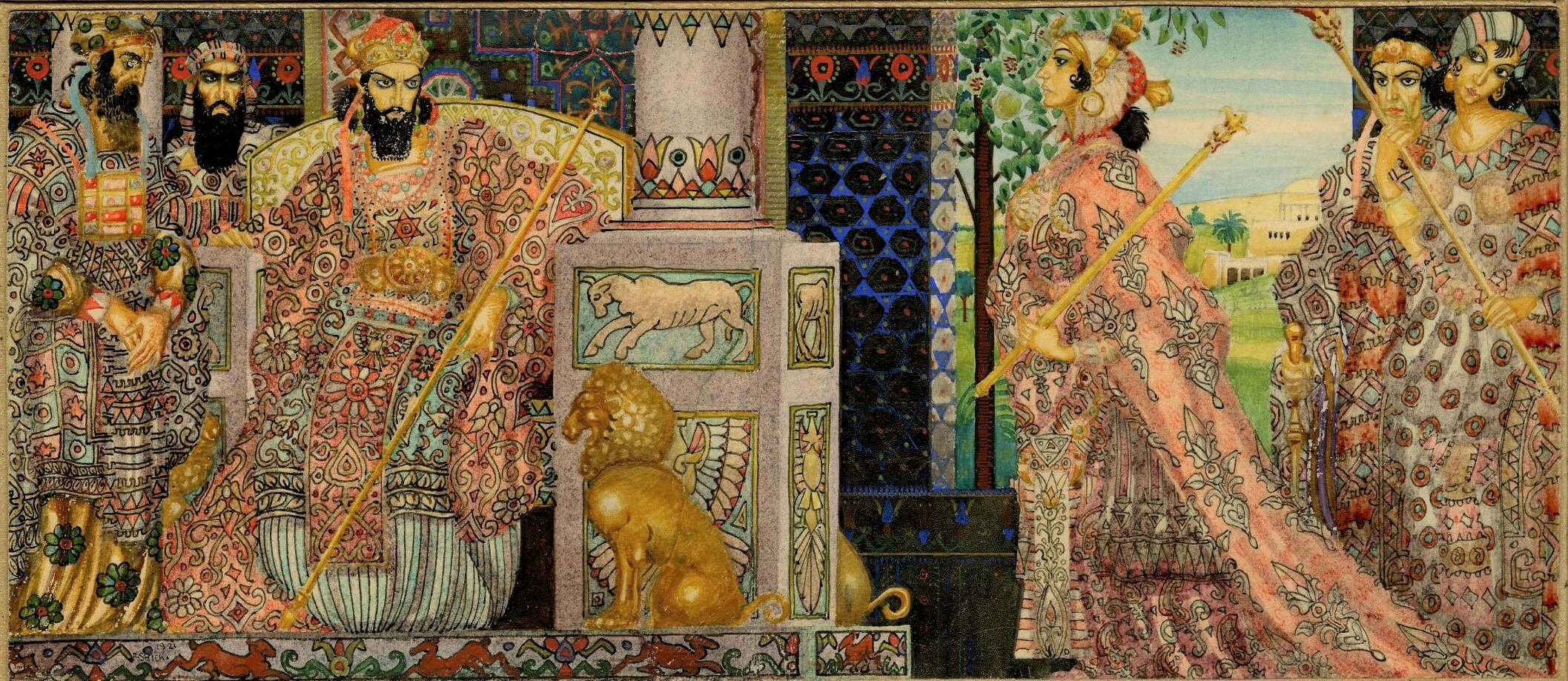
Running through July 26, 2026, the show includes 18 never-before-seen pieces and 38 original works, the majority of which are on loan from Irvin Ungar, a rabbi-turned-antiquarian.
The show includes commercial cartoons Szyk produced for Collier’s Magazine and illuminated manuscripts, as well as his 1928–1929 sketchbook for the Washington and His Times series. Visitors get an up close look at the painstaking labor required to accurately show pivotal battle scenes from the American Revolution as well as Szyk’s efforts to draft the highly specific weaponry and military dress of the Revolution’s fighters.
A fierce anti-fascist, themes of military might pervaded Szyk’s works throughout World War II.
This is never more evident than in his 1942 suite illustrating the Four Freedoms that hung in President Franklin D. Roosevelt’s White House. Each miniature, on display for the first time in 80 years, portrays a medieval knight on a quest to secure Roosevelt’s four essential freedoms — Speech, Religion, Want and Fear.
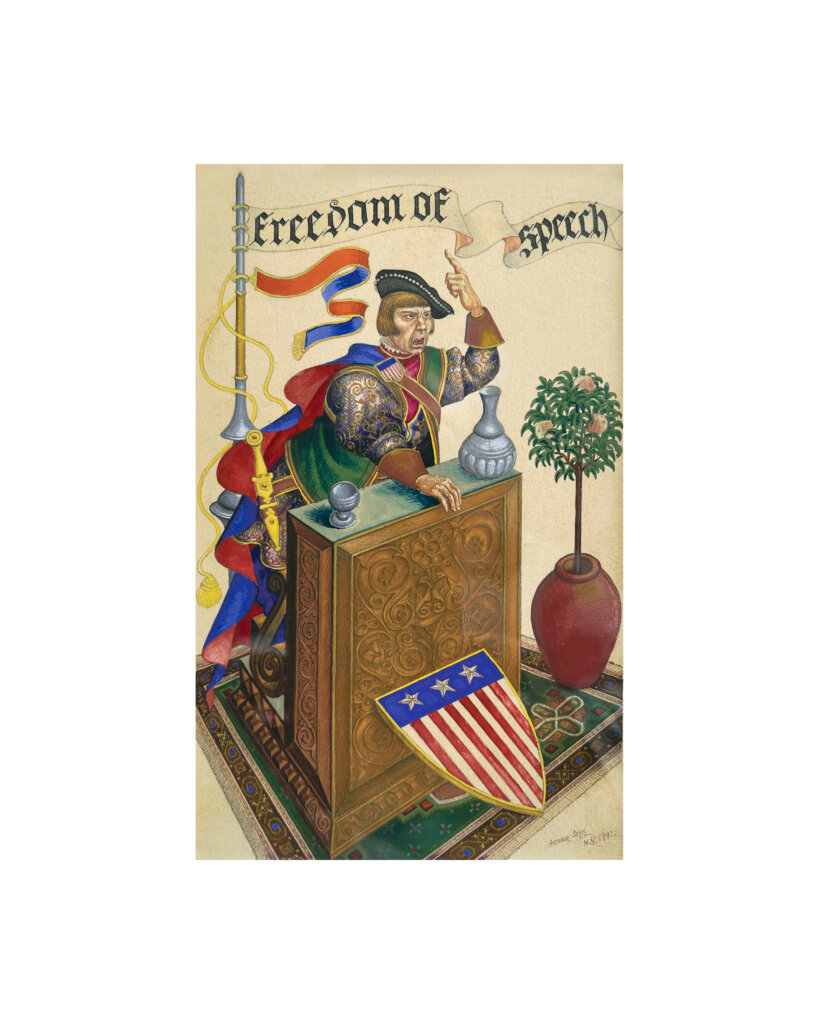
Freedom of Speech shows the knight wearing a red and blue cape pounding a lectern as he speaks freely; a shield embossed in the colors of the American flag rests nearby. In Freedom from Want, abundant food surrounds the knight, in Freedom of Religion he kneels in prayer and in Freedom of Fear he charges into battle.
Many of Szyk’s works meld American ideals with his firm belief that the government must do all it can to rescue Jews. During this period, many of his miniatures were sold as stamps and posters to generate much needed wartime funds. In this way, Szyk not only highlighted the fight against the Nazis, he cemented the defense of these freedoms as a moral obligation for all Americans.
“The exhibition is a portrait of a person who, with his pen, inks and gouaches, never put down the fight — whether for Allied victory or Jewish salvation or, what his career embodied so thoroughly, for freedom of expression,” Softness said.
The latter eventually drew the glare of the House Un-American Activities Committee. Szyk was primarily investigated for his works that challenged racism, whether it was highlighting the experience of Black veterans during World War II or the segregationist policies of the South, as well as his outspoken support for Jewish refugees.
Like the medieval knight he depicted in Freedom from Fear, Szyk charged ahead. Indeed he threw down the gauntlet in his 1951 piece, Thomas Jefferson’s Oath.
The jewel-toned work illuminates Jefferson’s famous quote: “I have sworn upon the altar of God eternal hostility against every form of tyranny over the mind of man.”
74 years after he died in his home in New Canaan, Szyk’s legacy endures.
“He refused to dilute identity or politics. He worked loudly, explicitly, and without apology — a proud American, a committed Jew, and a relentless defender of civil rights,” Softness said.
The post An activist Jewish artist who used his work to fight fascism appeared first on The Forward.
Uncategorized
Israel’s Top Diplomat Calls on Jews to Make Aliyah Amid Global Surge in Antisemitic Violence

Israel’s Foreign Minister Gideon Saar attends a press conference with the Danish Foreign Minister (not pictured) in Jerusalem, Sept. 7, 2025. Photo: Ritzau Scanpix/Ida Marie Odgaard/via REUTERS
Amid a global surge in antisemitic violence, Israeli Foreign Minister Gideon Saar has urged Jews living abroad to make aliyah to Israel, warning that diaspora communities are increasingly vulnerable to hatred and hostility as foreign governments fail to protect them.
“Over the past year, we have concentrated efforts in the fight against the rising antisemitism around the world,” Saar said Sunday during a Hanukkah candle-lighting event in Rishon LeZion, a city in central Israel.
“We demanded that foreign governments take real steps against the new antisemitism. Few did so. Most allowed an unrestrained surge of overt antisemitism in the public sphere,” the top Israeli diplomat continued.
Saar’s latest remarks come in the wake of a deadly attack on a Hanukkah celebration at Sydney’s Bondi Beach last Sunday, which left 15 dead and at least 40 injured.
Earlier this year, a string of deadly terrorist attacks also targeted Jewish communities, including the Yom Kippur assault in Manchester that killed two Jewish men, the firebombing of a march for Israeli hostages in Boulder, Colorado – which killed one and injured 13 – and the murder of two Israeli Embassy staffers in Washington, DC.
“Jews have the right to live in safety everywhere. Today, Jews are being hunted across the world. Today I call on Jews in England, Jews in France, Jews in Australia, Jews in Canada, Jews in Belgium: come to the Land of Israel! Come home!” Saar said during his speech.
“We are waiting for you here with open arms. With love. In the true home of the Jewish people. Why raise your children in this atmosphere?” the Israeli diplomat continued. “Come with your families to the land of our forefathers, to the State of Israel, where the Jews taught the entire world what Jewish self-defense means. The time has come.”
Jewish communities around the world, especially in Europe, have faced a troubling surge in antisemitic incidents and anti-Israel sentiment since the Hamas-led invasion of and massacre across southern Israel on Oct. 7, 2023.
Jewish leaders have consistently called on authorities to take swift action against the rising wave of targeted attacks and anti-Jewish hate crimes, ranging from the vandalism of murals and businesses to violent physical assaults, that their communities continue to face.
In the United Kingdom, more than half of British Jews — 51 percent — believe they have no long-term future in the country or elsewhere in Europe, according to a survey conducted by the Campaign Against Antisemitism, released Monday.
Amid this climate of rising hostility, almost half of British Jews (45 percent) report feeling unwelcome in the UK, while a majority (61 percent) have considered leaving the country in the past two years, citing the recent surge in antisemitism as the main reason.
The newly released report also found that 59 percent of British Jews try to avoid displaying visible signs of their Jewish identity out of fear of antisemitic attacks, while 96 percent believe that Jews in Britain are less safe now than they were before the Oct. 7 atrocities.
Fewer than one in ten British Jews believe authorities are doing enough to tackle antisemitism, with only 14 percent feeling that the police are adequately protecting them.
In France, the local Jewish community has also faced a growing climate of hostility and antisemitic violence, which has even extended into politics, sparking national debates and drawing condemnation from leaders and civil society groups.
In one of the latest controversies, Bernard Bazinet, the mayor of Augignac in the southwestern Dordogne region, was expelled from the French Socialist Party earlier this month after posting antisemitic comments online about Israel’s participation in the Eurovision Song Contest.
“France is too Jewish to boycott [Eurovision]!” Bazinet wrote in a post on Facebook.
French Interior Minister Laurent Nuñez strongly condemned Bazinet’s comments, warning that he could face sanctions ranging from suspension to outright dismissal.
However, the rising wave of antisemitic attacks and hatred has spread beyond Western countries, reaching nations across the Eastern Mediterranean and other regions worldwide.
On Sunday, a group of Jews in Istanbul were attacked by pro-Palestinian protesters while on their way to light the eighth and final Hanukkah candle at the Neve Shalom synagogue.
According to widely circulated social media videos, the attackers approached the group while shouting, “These Zionists should leave this country,” waving Palestinian flags as they tried to get closer.
In a separate incident over the weekend, an Israeli man was attacked outside the hotel where he was staying in Limassol, Cyprus, after assailants reportedly heard him speaking Hebrew on the phone.
According to the victim’s father, his son was talking on the phone when a man approached him, asked for a cigarette, and then brutally assaulted him.
The victim was rushed to a local hospital and then flown to Israel on Sunday for emergency eye surgery after the attack, but doctors were unable to save his vision.
“My son, a young Israeli, was violently attacked at the entrance to the hotel where he was staying in Cyprus. Not on the street, not in a bar. At the entrance to the hotel — a place that is supposed to be safe and secure,” the victim’s father wrote in a post on Facebook. “He was brutally beaten, injured in the head and face, and evacuated for medical treatment.”

